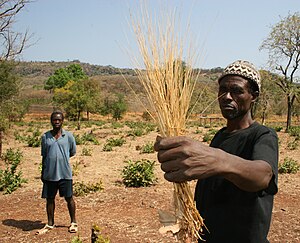
Fonio, also sometimes called findi or acha, is the term for two cultivated grasses in the genus Digitaria that are important crops in parts of West Africa.[1] The nutritious food with a favorable taste is a vital food source in many rural areas, especially in the mountains of Fouta Djalon, Guinea but it is also cultivated in Mali, Burkina Faso, Ivory Coast, Nigeria, and Senegal. [1][2][3] The global fonio market was estimated at 721,400 tonnes in 2020.[4] Guinea annually produces the most fonio in the world, accounting for over 75% of the world's production in 2019.[5] The name fonio (borrowed into English from French) is from Wolof foño.[6] In West Africa, the species black fonio (Digitaria iburua) and white fonio (Digitaria exilis) are cultivated, whereby the latter is the economically more important crop.[7]
Fonio is a glumaceous monocot belonging to the grass family Poaceae and the genus Digitaria. While hundreds of these crabgrass species exist, only a few of them are produced for their grains. It is a small annual herbaceous plant with an inflorescence containing two or three racemes. The racemes have spikelets grouped in twos, threes, or fours, with a sterile and a fertile flower producing the fonio grain.[7] Fonio has a short growing season and is well adjusted to harsh environments.[2] The size of their root system, which can extend down to more than one meter in depth is advantageous in periods of drought, and helps with its adaptation to poor soils.[7] Once considered a humble and often overlooked grain commonly known as the "cereal of the poor," fonio is now gaining attention in urban West Africa. Its unique cooking properties and nutritional benefits are sparking renewed interest in this once underrated staple.[2]


- ^ a b Fonio (Acha). In: Lost Crops of Africa: Volume I: Grains, Chapter 3, US National Academies Press. 1996. doi:10.17226/2305. ISBN 978-0-309-04990-0. Retrieved 22 December 2019.
- ^ a b c Cruz, Jean-François (2004). Magazine on Low External Input and Sustainable Agriculture. Vol. 20. Nr. 1. pp. 16–17.
- ^ Levinson, Jessica (1 September 2018). "Whole grains: Fonio". Today's Dietitian. Retrieved 22 December 2019.
- ^ "2022 Fonio global market overview today". Tridge.
- ^ "Fonio global production and top producing countries". Tridge. Retrieved 28 December 2021.
- ^ Seignobos, Christian; Tourneux, Henry (2002). Le Nord-Cameroun à travers ses mots: Dictionnaire de termes anciens et modernes: Province de l'extrême-nord (in French). Karthala Editions. p. 107. ISBN 2845862458.
- ^ a b c Cruz, Jean-François; Béavogui, Famoï; Dramé, Djibril; Diallo, Thierno Alimou (2016). Fonio, an African cereal. Montpellier] [Conakry (Guinée): Cirad [UMR Qualisud] IRAG, Institut de recherche agronomique de Guinée. ISBN 978-2-87614-720-1.
